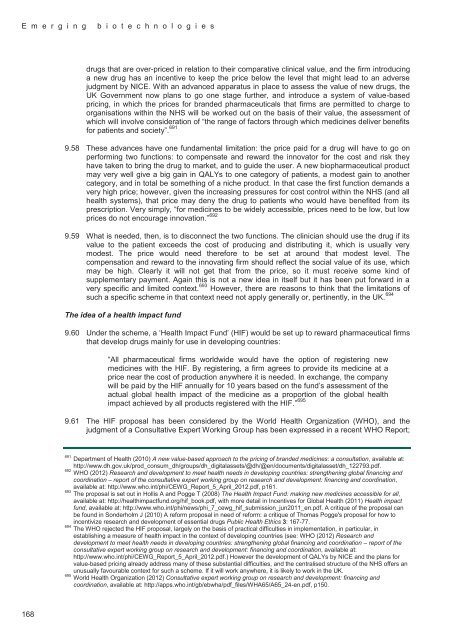Emerging biotechnologies: full report - Nuffield Council on Bioethics
Emerging biotechnologies: full report - Nuffield Council on Bioethics
Emerging biotechnologies: full report - Nuffield Council on Bioethics
You also want an ePaper? Increase the reach of your titles
YUMPU automatically turns print PDFs into web optimized ePapers that Google loves.
E m e r g i n g b i o t e c h n o l o g i e s<br />
drugs that are over-priced in relati<strong>on</strong> to their comparative clinical value, and the firm introducing<br />
a new drug has an incentive to keep the price below the level that might lead to an adverse<br />
judgment by NICE. With an advanced apparatus in place to assess the value of new drugs, the<br />
UK Government now plans to go <strong>on</strong>e stage further, and introduce a system of value-based<br />
pricing, in which the prices for branded pharmaceuticals that firms are permitted to charge to<br />
organisati<strong>on</strong>s within the NHS will be worked out <strong>on</strong> the basis of their value, the assessment of<br />
which will involve c<strong>on</strong>siderati<strong>on</strong> of “the range of factors through which medicines deliver benefits<br />
for patients and society”. 691<br />
9.58 These advances have <strong>on</strong>e fundamental limitati<strong>on</strong>: the price paid for a drug will have to go <strong>on</strong><br />
performing two functi<strong>on</strong>s: to compensate and reward the innovator for the cost and risk they<br />
have taken to bring the drug to market, and to guide the user. A new biopharmaceutical product<br />
may very well give a big gain in QALYs to <strong>on</strong>e category of patients, a modest gain to another<br />
category, and in total be something of a niche product. In that case the first functi<strong>on</strong> demands a<br />
very high price; however, given the increasing pressures for cost c<strong>on</strong>trol within the NHS (and all<br />
health systems), that price may deny the drug to patients who would have benefited from its<br />
prescripti<strong>on</strong>. Very simply, “for medicines to be widely accessible, prices need to be low, but low<br />
prices do not encourage innovati<strong>on</strong>.” 692<br />
9.59 What is needed, then, is to disc<strong>on</strong>nect the two functi<strong>on</strong>s. The clinician should use the drug if its<br />
value to the patient exceeds the cost of producing and distributing it, which is usually very<br />
modest. The price would need therefore to be set at around that modest level. The<br />
compensati<strong>on</strong> and reward to the innovating firm should reflect the social value of its use, which<br />
may be high. Clearly it will not get that from the price, so it must receive some kind of<br />
supplementary payment. Again this is not a new idea in itself but it has been put forward in a<br />
very specific and limited c<strong>on</strong>text. 693 However, there are reas<strong>on</strong>s to think that the limitati<strong>on</strong>s of<br />
such a specific scheme in that c<strong>on</strong>text need not apply generally or, pertinently, in the UK. 694<br />
The idea of a health impact fund<br />
9.60 Under the scheme, a ‘Health Impact Fund’ (HIF) would be set up to reward pharmaceutical firms<br />
that develop drugs mainly for use in developing countries:<br />
“All pharmaceutical firms worldwide would have the opti<strong>on</strong> of registering new<br />
medicines with the HIF. By registering, a firm agrees to provide its medicine at a<br />
price near the cost of producti<strong>on</strong> anywhere it is needed. In exchange, the company<br />
will be paid by the HIF annually for 10 years based <strong>on</strong> the fund’s assessment of the<br />
actual global health impact of the medicine as a proporti<strong>on</strong> of the global health<br />
impact achieved by all products registered with the HIF.” 695<br />
9.61 The HIF proposal has been c<strong>on</strong>sidered by the World Health Organizati<strong>on</strong> (WHO), and the<br />
judgment of a C<strong>on</strong>sultative Expert Working Group has been expressed in a recent WHO Report;<br />
691 Department of Health (2010) A new value-based approach to the pricing of branded medicines: a c<strong>on</strong>sultati<strong>on</strong>, available at:<br />
http://www.dh.gov.uk/prod_c<strong>on</strong>sum_dh/groups/dh_digitalassets/@dh/@en/documents/digitalasset/dh_122793.pdf.<br />
692 WHO (2012) Research and development to meet health needs in developing countries: strengthening global financing and<br />
coordinati<strong>on</strong> – <str<strong>on</strong>g>report</str<strong>on</strong>g> of the c<strong>on</strong>sultative expert working group <strong>on</strong> research and development: financing and coordinati<strong>on</strong>,<br />
available at: http://www.who.int/phi/CEWG_Report_5_April_2012.pdf, p161.<br />
693 The proposal is set out in Hollis A and Pogge T (2008) The Health Impact Fund: making new medicines accessible for all,<br />
available at: http://healthimpactfund.org/hif_book.pdf, with more detail in Incentives for Global Health (2011) Health impact<br />
fund, available at: http://www.who.int/phi/news/phi_7_cewg_hif_submissi<strong>on</strong>_jun2011_en.pdf. A critique of the proposal can<br />
be found in S<strong>on</strong>derholm J (2010) A reform proposal in need of reform: a critique of Thomas Pogge's proposal for how to<br />
incentivize research and development of essential drugs Public Health Ethics 3: 167-77.<br />
694 The WHO rejected the HIF proposal, largely <strong>on</strong> the basis of practical difficulties in implementati<strong>on</strong>, in particular, in<br />
establishing a measure of health impact in the c<strong>on</strong>text of developing countries (see: WHO (2012) Research and<br />
development to meet health needs in developing countries: strengthening global financing and coordinati<strong>on</strong> – <str<strong>on</strong>g>report</str<strong>on</strong>g> of the<br />
c<strong>on</strong>sultative expert working group <strong>on</strong> research and development: financing and coordinati<strong>on</strong>, available at:<br />
http://www.who.int/phi/CEWG_Report_5_April_2012.pdf.) However the development of QALYs by NICE and the plans for<br />
value-based pricing already address many of these substantial difficulties, and the centralised structure of the NHS offers an<br />
unusually favourable c<strong>on</strong>text for such a scheme. If it will work anywhere, it is likely to work in the UK.<br />
695 World Health Organizati<strong>on</strong> (2012) C<strong>on</strong>sultative expert working group <strong>on</strong> research and development: financing and<br />
coordinati<strong>on</strong>, available at: http://apps.who.int/gb/ebwha/pdf_files/WHA65/A65_24-en.pdf, p150.<br />
168
















